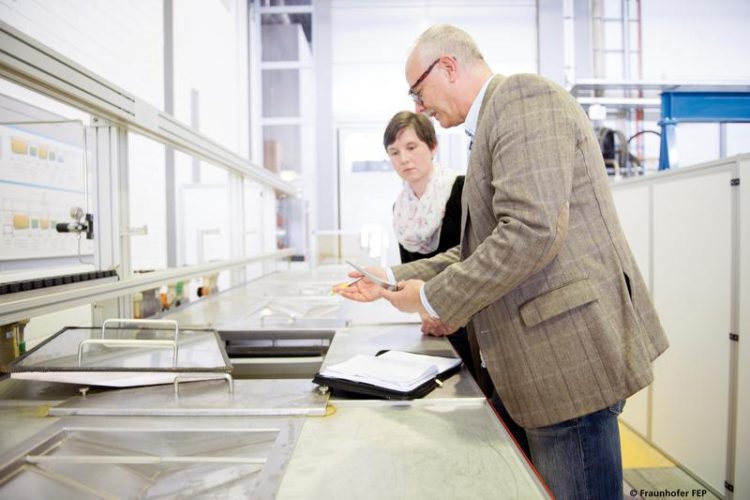We will find “the fly in the ointment” and show it to you

Frank-Holm Rögner in discussion with a customer during the process analysis Fraunhofer FEP
Who is not afraid of them: resistant hospital germs or contaminated packaging materials of foodstuff? But not just biological or chemical contaminations are horror scenarios. Also in the industrial production tiny particles or residues of production auxiliary materials affect the manufacturing process.
It is not unusual that adhering impurities – like finger prints on glass – are often impossible to remove with a justifiable effort. Therefore it is useful to consider the entire value chains, because often the use of process control techniques and the adjustment of production steps to avoid contaminations are more cost efficiently than the reduction of the pollution level by the cleaning processes themselves.
The scientists of Fraunhofer FEP are optimally equipped for the fight against all kinds of contamination. For this purpose a wide range of tested and innovative technologies are at their disposal: from the disinfection of seeds using accelerated electrons to the optical detection of tiniest particles on films for the organic electronics.
Frank-Holm Rögner, head of the department for electron beam processes, says: „We consult customers with our know-how regarding coating technology, material processing, joining technology or organic electronics. The processes can be optimized and the quality of the end product can be improved significantly. We accompany our customers from the process analysis to the development of integrated cleaning solutions, the selection of suitable plant technology up to the evaluation of replacement and new investments.”
The Fraunhofer FEP and the Fraunhofer IPM cooperate in order to achieve optimal results in process optimization and cleaning consulting for industry partners. The main focus hereby is on the process analysis to prevent contaminations and for the quality assurance.
At the joint booth of Fraunhofer at parts2clean visitors can try out an example for such an integrated solution for the process monitoring. The technology of imaging fluorescence was developed by the Fraunhofer IPM. Fluorescent contaminations like fingerprints, hair and production auxiliary materials can be detected by imaging on different products.
For André Weidauer, project manager at the Fraunhofer FEP, a typical consulting contract in the industry is as follows: “First of all we check the entire process chain for contamination potential as well as measurement methods and cleaning processes, which have already been applied. Together with the customer we develop the optimal composition and monitoring of the entire process and discuss suitable plant concepts. In advance we test the methods, which are suitable for the customers, directly on the plants of our institute or with partners of the Fraunhofer alliance for cleaning technology. We also support the customers during commissioning of the new process technology and train all employees involved.”
The scientists of Fraunhofer IPM and FEP are looking forward to new, exciting projects to help making processes and products of their industry customers even safer and more economical.
Press contact:
Mrs. Annett Arnold
Fraunhofer Institute for Organic Electronics, Electron Beam and Plasma Technology FEP | Phone +49 351 2586 452 | annett.arnold@fep.fraunhofer.de
Winterbergstraße 28 | 01277 Dresden | Germany | www.fep.fraunhofer.de
Media Contact
All latest news from the category: Trade Fair News
Newest articles

Parallel Paths: Understanding Malaria Resistance in Chimpanzees and Humans
The closest relatives of humans adapt genetically to habitats and infections Survival of the Fittest: Genetic Adaptations Uncovered in Chimpanzees Görlitz, 10.01.2025. Chimpanzees have genetic adaptations that help them survive…

You are What You Eat—Stanford Study Links Fiber to Anti-Cancer Gene Modulation
The Fiber Gap: A Growing Concern in American Diets Fiber is well known to be an important part of a healthy diet, yet less than 10% of Americans eat the minimum recommended…

Trust Your Gut—RNA-Protein Discovery for Better Immunity
HIRI researchers uncover control mechanisms of polysaccharide utilization in Bacteroides thetaiotaomicron. Researchers at the Helmholtz Institute for RNA-based Infection Research (HIRI) and the Julius-Maximilians-Universität (JMU) in Würzburg have identified a…



